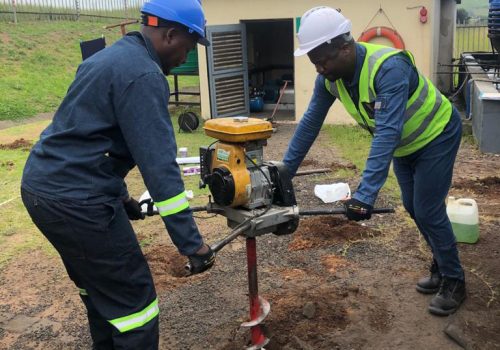We carry out air quality monitoring in accordance with the National Environmental Management: Air Quality Act 39 of 2004 (AQA). Our objective is to manage air quality and safeguard public health by establishing regulatory standards, necessitating the development of emission reduction plans, and implementing enforcement measures.
AIR QUALITY MONITORING
A. Dust Fallout Monitoring and Measurements
- Conduct dust fallout monitoring in accordance with SANS 1137.
- Ensure compliance with dust control regulations, including the fabrication of portable single-bucket and multi-directional monitoring units.
- Select and place monitoring sites for optimal effectiveness.
- Perform regular sample collection, filtration, and data analysis.
- Utilize the ASTM D1739 method as the current standard testing procedure under the National Dust Control Regulations.
- Use data to evaluate the effectiveness of dust control plans.
- Develop site-specific strategies to reduce dust emissions and create a comprehensive dust management plan to control and monitor dust fallout.
- Prepare detailed reports based on the findings.

C. Ambient Air Quality Monitoring
The evaluation of compliance with ambient air quality standards involves several essential activities, which include the following:
1. Implementation of fenceline air quality monitoring systems.
2. Conducting measurements of particulate matter, specifically Total Suspended Particles (TSP), PM10, PM5, and PM1.
3. Measurement of gaseous pollutants, including sulfur dioxide (SO2) and nitrogen oxides (NOx).
4. Assessment of organic compounds, particularly polycyclic aromatic hydrocarbons (PAH).
5. Measurement of pertinent meteorological parameters.
6. Execution of both periodic and continuous assessments of air pollution.
7. Utilization of both active and passive sampling techniques.
8. Preparation of compliance reports.
9. Installation, maintenance, and operation of ambient air quality monitoring equipment and stations.
B. Isokinetic/Stack Emissions Sampling
Isokinetic stack monitoring involves the systematic collection of gas samples at a velocity that corresponds with the gas flow within the stack, thereby ensuring an accurate representation of the emitted pollutants. This method is particularly essential for monitoring particulate matter, as concentrations may vary throughout the stack.
Types of Emissions Tested
Stack emission testing encompasses a broad spectrum of pollutants released into the atmosphere. Common emissions that are routinely assessed include:
Particulate Matter (PM)
Particulate matter comprises minute solid or liquid particles suspended in the air. Stack emission testing quantifies the concentration of PM, which includes dust, soot, and other fine particles that pose health risks when inhaled.
Volatile Organic Compounds (VOCs)
VOCs refer to carbon-based chemicals that readily vaporize at room temperature. Industries that emit VOCs, such as those involving solvents and fuels, are subjected to stack emission testing to ensure compliance with regulatory limits, given their significant contributions to air pollution and associated health risks.
Nitrogen Oxides (NOx)
NOx compounds, primarily nitrogen dioxide (NO2) and nitric oxide (NO), are generated during high-temperature combustion processes. Stack emission testing evaluates NOx levels to determine the efficiency of combustion systems and assess the environmental impact of industrial operations.
Sulfur Oxides (SOx)
SOx emissions primarily result from the combustion of fossil fuels containing sulfur, such as coal and oil. Stack emission testing monitors SOx levels to evaluate compliance with emissions standards and assess the effectiveness of flue gas desulfurization systems.
Stack Emission Testing with Apex Environmental
Particulate Matter (PM) Sampling
This methodology quantifies the concentration of fine particles present in the air, which can adversely affect human health while also contributing to climate change.
Sulfur Dioxide (SO2) Sampling
This technique measures the amount of sulfur dioxide in the atmosphere. SO2 is a major contributor to acid rain, which poses threats to ecosystems and infrastructure.
Nitrogen Oxide (NOx) Sampling
This method assesses the concentration of nitrogen oxides in the air. NOx significantly contributes to the formation of smog, which is associated with respiratory issues.
The results obtained from stack emission testing can be utilized for various purposes:
1. Compliance with Air Quality Regulations
Numerous industries are mandated to adhere to stringent air quality regulations. These tests provide assurance that such regulations are being satisfied.
2. Identification of Improvement Areas
The findings from stack emission testing can reveal opportunities for emissions reduction, thus contributing to enhanced air quality and the protection of public health.
3. Development of Emission Inventories
Emission inventories serve to track the volume of air pollutants emitted from various sources. Stack emission testing provides critical data for these inventories.
Overall, this methodology is a fundamental tool for monitoring and controlling industrial emissions. By accurately measuring and analyzing diverse pollutants, industries can ensure adherence to regulatory standards, mitigate environmental impact, and protect human health.

D. Air Quality Legislation/Regulation
- Air Emission License (AEL) Applications, Management &Compliance Monitoring
- National Atmospheric Emissions Inventory System (NAEIS) Reporting Support
- Air Quality Management Plans (AQMP)
- Air Quality Impacts Assessments (AQIA)
- Pollution Prevention Plans (PPPs)
- Emissions Inventories
- Dispersion Modelling
CLIMATE CHANGE
- Climate Change Regulations Awareness and Training
- Greenhouse Gas Emissions Inventory
- Greenhouse Gas Reporting Registration and Compliance Support
- Carbon Footprint Assessments
- Carbon Tax Bill
- Industry awareness and training on compliance requirements
- Carbon Tax Liability assessments and estimations
- GHG emissions reduction strategies/plans development
WATER SAMPLING
Thlago conducts drinking, surface, and underground water sampling for Analysis in the Laboratory. The following tests are undertaken on the water samples collected:
- Microbiological quality
- Physical quality & properties
- Chemical quality and content
SOIL SAMPLING

- Thlago uses both national and international standards and methods to collect soil samples as stipulated in the Department of Environmental Affairs National Norms and Standards for the Remediation of Contaminated Land and Soil Quality in South Africa, published in 2013
- Thlago follows norms and standards published in the National Environmental Management: Waste Act (NEMWA) (Act 59 of 2008) to assess contaminated land to establish the potential risks to human health and the environment
- Thlago undertakes soil assessments and screening for a range of metals, organics and anions.
- Results will be evaluated against the soil screening values
ENVIRONMENTAL NOISE
- The environmental noise survey will be conducted according to SANS 10103:2008, the Code of Practice for “The Measurement and Rating of Environmental
- Noise with Respect to Land Use, Health, Annoyance and Speech Communication”. The code recommends maximum noise levels for Day and Night-Time limits in different environments

ENVIRONMENTAL Technicians

Dakalo Phophi

George Chabalala
